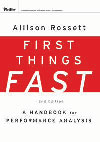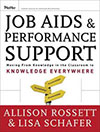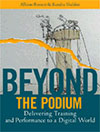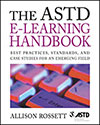I’d like to introduce you to a friend, Rob Foshay. Rob is my guest blogger and a pal for decades. Here is what Rob has to say:
 So, you know what the gaps are between your company’s average performers, and their expert performers. And, you’ve done your analysis of the job skills involved. And you’ve done your gap analysis to figure out what the highest priorities are for training. Are you really focused on what’s most important for your company (or client)?
So, you know what the gaps are between your company’s average performers, and their expert performers. And, you’ve done your analysis of the job skills involved. And you’ve done your gap analysis to figure out what the highest priorities are for training. Are you really focused on what’s most important for your company (or client)?
Maybe not.
There might be an entire category of job performance that your analysis has missed: It’s what your master performers have – but it may not even be understandable to your “average” performers. And, typical front-end analyses may not even identify it.
Your managers know it when they see it in their “MVP.” You know, the one who can provide innovative, valuable solutions to your customers. The one who knows the jargon, products and tools of your company, but who goes beyond that to really listen to the customer’s need, and meet them in creative ways. The one who adds value to customer relationships by inventing new solutions, not just delivering products. The one who has been around for a long time, seen all the weird stuff before, and can find a way to do what the customer needs when others are stumped – and probably faster than anyone else could. That’s expertise, and it exists at every level of your organization. It’s your most valuable competitive asset – and also your scarcest. That scarcity is probably the greatest single factor limiting your growth. It also goes home every night, and it’s what you lose when your MVP retires or goes over to the competition.
People usually think of expertise as a “black box” – something which is unknowable, and certainly not written down anywhere. McKinsey uses the term tacit knowledge to describe this most critical asset.[1] But breakthroughs in learning sciences research have shown how to make this knowledge explicit, where everyone can learn and use it. The research has shown that expertise derives from four types of knowledge: ill-structured problem solving, which is based on a rich understanding of how things work, and a mastery of problem-solving strategies which work within a specific context. Let’s look at each of these in more detail.
What makes your MVP special is the ability to solve ill-structured problems. These are the problems which have something unique about them, whether it’s designing a new solution strategy, or envisioning a new skyscraper. These problems are at the opposite end of the continuum from well-structured problems, which we all solve every day. What’s the difference? Any problem can be described in terms of a starting state (the inputs), a solution process, and a goal state (the outputs). In ill-structured problems, things aren’t well defined. You know your starting state, but you may not know what a good solution looks like (there may even be many possible good solutions), and you probably need to invent a way to arrive at the solution (and there may be many of those, too). These problems are embedded in any business, at nearly every level beyond entry level. In practically any enterprise, and at almost any level of the organization, the real value added to the customer (whether internal or external) comes from ill-structured problem solving. For sales it’s solution selling. For managers it’s both the problem solving within the financial and technical sides of the business, and the problem solving within the organization (the people side of the business). For doctors, it’s medical diagnosis. For architects and engineers, it’s design. For advertisers, it’s everything from conceiving an advertising campaign strategy to writing the copy. For service technicians, it’s troubleshooting a new problem or a new piece of equipment.
But ill-structured problem solving expertise doesn’t exist by itself. It’s based on three kinds of knowledge: how things work, problem solving strategies, and context knowledge.
How things work is the expert’s understanding of the system which they manipulate when they solve problems.
Problem solving strategies are the general rules an expert knows about how to solve problems of a particular type.
Experts also have a great deal of context knowledge.
To reiterate: it is the combination of all three of these types of knowledge which makes for expertise:
- How things work
- Context knowledge
- Ill-structured problem-solving strategies (decision rules or heuristics)
To make an expert ill-structured problem solver, all are necessary.
There’s a good chance that these types of knowledge aren’t written down anywhere in your company, nor are they part of your training or certification systems. But using special analytical techniques developed by learning science researchers, it is possible to make these types of knowledge explicit. Once you have done so, then the expertise of your company becomes a scalable and reproducible asset.
[1] Johnson, B.C., Manyika, J.M., Yee, L.A. (2005) The next revolution in interactions. The McKinsey Quarterly, 2005 (4). Note that the term tacit knowledge originated with the philosopher-mathematician Polanyi.
Rob Foshay is President of The Foshay Group, specializing in high-value strategies for training, technology, and certification.
Dr. Foshay’s background includes over 25 years experience of leadership in corporate technology-based training, as well as faculty positions at the high school and university levels. His doctorate is in instructional design from Indiana University. He has authored and edited books on instructional design, and has contributed over 70 major articles to research journals and books on a wide variety of topics in training, technology and education. He speaks frequently before educators and trainers world-wide. He currently serves on the editorial boards of three research journals, and has served on the Board of Directors of the International Society for Performance Improvement and the International Board of Standards for Training, Performance and Instruction.





